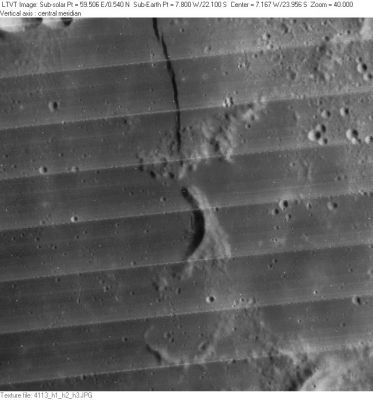Stag's Horn Mountains
Contents
Stag's Horn Mountains
(unofficial name; former IAU name (in part): Thebit Alpha)
| Lat: 23.9°S, Long: 7.1°W, Diameter: 134 km, Height: 0.9 km, Rükl: 54 |
LO-IV-113H The dark vertical line is the southern part of Rupes Recta (the Straight Wall), and the craters barely visible in the upper left are Birt and Birt A. The structure in the extreme lower right is the northwest rim of 29-km Purbach H. The Stag's Horn Mountains is the group of hills near the center of this image, with the prominent crescent-shaped peak having once been officially known as Thebit Alpha). See Nomenclature (below) for additional IAU names in this field.
Images
LPOD Photo Gallery Lunar Orbiter Images Apollo Images
Maps
(LAC zone 95A4) LAC map Geologic map
Description
A group of hills at the south end of Rupes Recta, representing rims of ancient craters flooded by Mare Nubium.
Description: Elger
- THE STRAIGHT WALL.-- ... terminating on the south at a very peculiar mountain group, the shape of which has been compared to a stag's horn, but which perhaps more closely resembles a sword-handle,--the wall representing the blade.
- THE STAG'S-HORN MOUNTAINS.--At the S. end of THE STRAIGHT WALL, or "railroad," in S. lat. 24 deg., W. long. 8 deg., a curious mountain mass rising about 2000 feet above the Mare Nubium.
Description: Wikipedia
Additional Information
- From the shadows in LO-IV-113H, the peak of the crescent-shaped hill rises about 875 m above the mare. LAC-95 gives 850 m for a shadow measured in the opposite direction. - JimMosher
- Charles Wood has suggested that the horizontal component of the Stag's Horn Mountains might be a remnant of the southern part of the inner ring of an impact basin he calls Ancient Thebit.
Nomenclature
- Stag's Horn Mountains has never been an official IAU name, but it is nonetheless a traditional name with a long history. Precisely which peaks various observers meant to include in the name is probably not well defined.
- According to page 134 of T.W.Webb's Celestial Objects for Common Telescopes, Volume One: The Solar System, it was Beer and Madler who called these the Stag's Horn Mountains, because these mountains (together with Rupes Recta) "appear like a staff tipped with a stag's horn". Research: Danny Caes.
- The prominent crescent-shaped hill had the official name Thebit Alpha in both the original IAU nomenclature of Blagg and Müller and in the System of Lunar Craters. It appears to be the remnant of a flooded crater about 25 km in diameter, but that crater has never had an IAU name. On the other hand, the region to the south of this peak (ending in the much more subdued crescent oriented like a smile) is regarded as 16-km Thebit S; and the much larger vaguely circular 78-km diameter region bounded by the Stag's Horn Mountains on its west (the right side of the Lunar Orbiter image) is Thebit P.
- Greek-lettered peak names were dropped by the IAU in 1973, and Thebit Alpha has not been re-named.
- Although named the "stag's horn" mountains, observers from Christiaan Huygens to Elger have noted that under many lighting conditions these hills look much more like the handle of a sword (with Rupes Recta being the sword blade).
LPOD Articles
Narrow View with Wide Implications
(see also Rupes Recta)
Succession
Bibliography
Many not-so-recent books on moon observing, and several moonmaps.
The name "Stag's Horn mountains" is not mentioned in Antonin Rukl's Atlas of the Moon.
